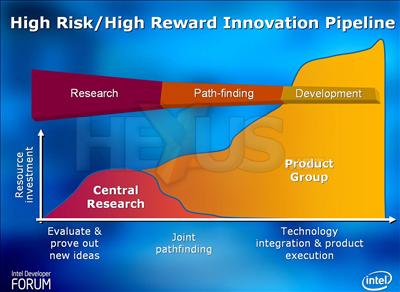Day Zero of the Intel Developer Forum - the warm up day, if you will - kicked off Monday with Abel Weinrib giving a presentation on the Corporate Technology Group, of which he is Vice President and Director.
The Corporate Technology Group (or CTG, because that sounds cooler, OK?) has a continuing mission to explore strange new avenues of research and seek out new innovatory technologies, all in aid of Intel's future technology platforms. This isn't Star Trek, this is R&D. The efforts of the CTG result in technology that benefits Intel and impacts the industry as a whole.
The CTG has four core roles: Working a high risk, high reward pipeline of innovation; technology leadership; coupling with the larger research community; and creating a favourable environment for technology. Let's start with the pipeline.
The first part of the innovation process is, of course, new ideas. These must be researched and evaluated for feasibility and benefit. As an idea comes to fruition, the central research group combine efforts with the product group to find a path through to product development. The deeper into the pipeline they go, the more resources are invested into a project and so there is a commitment to follow through with the development and get useable technology or products at the end of the pipeline.
Some examples of what have come out of the development pipeline in past years include Intel's three big platforms - Centrino, vPro and Viiv - along with MIMO technology for speedier wireless communication, which is now in the IEEE 802.16 standard and will be in 802.11n, when it's finally complete.
With innovation comes the realisation of the CTG's second core role: technology leadership. In 2005 Intel filed 473 patents and had 230 issued. Not quite IBM-sized numbers, but still, they're active innovators.
The 'research community' with which the CTG works ranges from DARPA through to universities around the world (Tsinghua, Berkeley, Cambridge...) Intel's researchers work with academics on joint IP (Intellectual Property) strategies. This connects Intel with the innovatory power and resources of the academic community and gives them a good view of what the whole research community is working on.
Currently in the innovation pipeline are Intel's 'platforms for the future', in which the company has a vision of one tenth the power consumption and ten times the performance. There are several technologies being worked on for these future platforms, here are a couple of examples:
Trusted computing - Taking current technologies further and implementing new trust technologies to ensure computers are used by the right people and in the right ways. (Yes, we know it sounds nasty, but hang around for our story on Phil Wennblom's Day Zero presentation if you need some help sleeping tonight.)
Then there's Silicon Photonics. That's processors using fricking lasers, folks! Indeed there's been talk about this very recently, the company making breakthroughs in getting silicon to produce laser light. Light's fast; you don't need us to tell you that.
Finally there's Tera-scale networking, on which you can find out more in another article that'll be published shortly.














